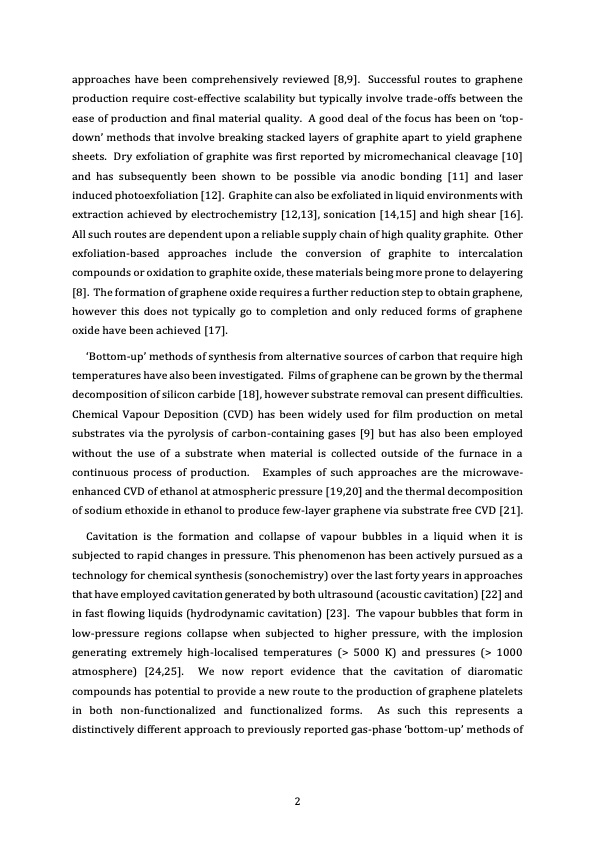
PDF Publication Title:
Text from PDF Page: 003
approaches have been comprehensively reviewed [8,9]. Successful routes to graphene production require cost-effective scalability but typically involve trade-offs between the ease of production and final material quality. A good deal of the focus has been on ‘top- down’ methods that involve breaking stacked layers of graphite apart to yield graphene sheets. Dry exfoliation of graphite was first reported by micromechanical cleavage [10] and has subsequently been shown to be possible via anodic bonding [11] and laser induced photoexfoliation [12]. Graphite can also be exfoliated in liquid environments with extraction achieved by electrochemistry [12,13], sonication [14,15] and high shear [16]. All such routes are dependent upon a reliable supply chain of high quality graphite. Other exfoliation-based approaches include the conversion of graphite to intercalation compounds or oxidation to graphite oxide, these materials being more prone to delayering [8]. The formation of graphene oxide requires a further reduction step to obtain graphene, however this does not typically go to completion and only reduced forms of graphene oxide have been achieved [17]. ‘Bottom-up’ methods of synthesis from alternative sources of carbon that require high temperatures have also been investigated. Films of graphene can be grown by the thermal decomposition of silicon carbide [18], however substrate removal can present difficulties. Chemical Vapour Deposition (CVD) has been widely used for film production on metal substrates via the pyrolysis of carbon-containing gases [9] but has also been employed without the use of a substrate when material is collected outside of the furnace in a continuous process of production. Examples of such approaches are the microwave- enhanced CVD of ethanol at atmospheric pressure [19,20] and the thermal decomposition of sodium ethoxide in ethanol to produce few-layer graphene via substrate free CVD [21]. Cavitation is the formation and collapse of vapour bubbles in a liquid when it is subjected to rapid changes in pressure. This phenomenon has been actively pursued as a technology for chemical synthesis (sonochemistry) over the last forty years in approaches that have employed cavitation generated by both ultrasound (acoustic cavitation) [22] and in fast flowing liquids (hydrodynamic cavitation) [23]. The vapour bubbles that form in low-pressure regions collapse when subjected to higher pressure, with the implosion generating extremely high-localised temperatures (> 5000 K) and pressures (> 1000 atmosphere) [24,25]. We now report evidence that the cavitation of diaromatic compounds has potential to provide a new route to the production of graphene platelets in both non-functionalized and functionalized forms. As such this represents a distinctively different approach to previously reported gas-phase ‘bottom-up’ methods of 2PDF Image | graphene platelets with partial oxidation via cavitation

PDF Search Title:
graphene platelets with partial oxidation via cavitationOriginal File Name Searched:
Sonochemistry-Chester-Rep.pdfDIY PDF Search: Google It | Yahoo | Bing
Salgenx Redox Flow Battery Technology: Power up your energy storage game with Salgenx Salt Water Battery. With its advanced technology, the flow battery provides reliable, scalable, and sustainable energy storage for utility-scale projects. Upgrade to a Salgenx flow battery today and take control of your energy future.
| CONTACT TEL: 608-238-6001 Email: greg@infinityturbine.com | RSS | AMP |